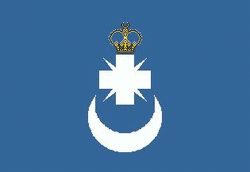
Flag of Afrazure
The Kingdom of Afrazure, commonly known simply as Afrazure (in Afrazlala, Afrazah), is a country located in the western part of the continent of Melania. Formerly the corelands of an independent Empire of Afrazure and later a colony and a vassal of Maurestania, the country fell into a civil war from the 270s until the late 290s. Afrazure was partioned by foreign powers in 299AP and the southern and southeastern provinces were made a protectorate of Altland in 300AP, under the name Afrazure Altlandique. Afrazure regained its complete sovereignty in 305, albeit the country has since been kept as a member of the Altlandic Family of Nations.
Etymology[]
Afrazure is the common Ingallish translation of the local toponym - in Afrazlala, Afrazah. The country is also known in other local languages as Azraq. During the colonial period, the nation was also known as Africablue, an inelegant rendering of the Afrazlala name.
History[]
Early Afrazure[]
Early hominids already roamed what is now Afrazure between 2.000.000 and 1.000.000 years ago. Modern Homo sapiens first reached the territory during the 8th and 7th milleniums before the Plague. Occasionally these native peoples would form powerful states and tribal confederations, such as the Shada, N'Koro and Azikwe. The first unified polity to use the name "Afrazure" name was the Empire of Afrazure, established circa 300BP under the Dulaid dinasty.
The last ruler of the Dulaid dinasty, Ellijah IX, died in 198BP without a heir, which prompted a minor civil war amongst several rival nobles. Eventually, a new dinasty was established under emperor Masaq I in 182BP. Afrazure was divided into a number of provinces, each ruled by a daam (a term normally translated as "duke"). Initially firmly controlled by the imperial government, the daams gained more power after the death of Youseff IX in 73BP. Under the new emperor, the weak Mahmoud II, the daams would start to effectvely act as independent warlords, raising taxes and maintaining private armies at will. Occasional local rebellions would be quelled by the daam armies.
Imperial unity, however, was kept by the necessities of the long-established commercial bonds that existed between the nomadic tribes of the interior, the masters of caravans and the city merchants of the coast.
The lessened imperial control, however, also allowed for some of the daams to launch slave expeditions deep into the Afrazurean jungles. Stervian slavers, for instance, decimated hundreds of native villages in order to capture new slaves, which were then transported abroad. From 100BP until the beginning of the Great Plague, over 350.000 Afrazurean natives were transported to the Samuelonian colonies of the Malvadorias.
The People's Empire[]
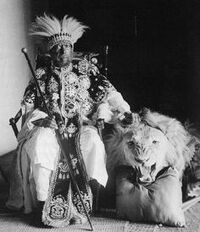
Yohannes I, the People's Emperor of the House of Mawuni.
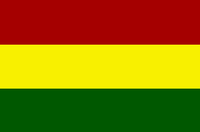
The colours of the Mawuni dinasty, normally used as a national flag during the People's Empire period.
In 121AP, a peasant army under Yohannes Mawuni was formed in what is now western Allacoa. Hundreds of thousands of local troops soon joined his rebellion. After his victories in the battles of Qocha (122AP) and Sotakhi (123AP), most of the daam warlord armies defected to Mawuni's rebellion. He entered the imperial capital Medhiou meeting no resistance, deposed the weak emperor Mahmoud II (who had ruled for nearly half a century), and was crowned as Yohannes I. Due to his humble origins, he quickly gained the sobriquet "The People's Emperor". Yohannes I would found the first universities in Afrazure and also begin the industrialization of the country, focusing mainly on shipbuilding and mining.
Yohannes I died in 163, after four decades of rule, and was succeded by his son, Meneliq I. Unfortunately for the new emperor, the foreign policy of neighbouring Maurestania had become increasingly imperialistic. The Maurestani-Afrazurean War began in August 173, when the first Maurestani troops crossed into Afrazurean territories. In the Battle of Was-Adaq, the core of the Maurestani army was crushed and the Afrazureans launched a quick counteroffensive. Surprisingly, by early 174, the Afazurean armies had already managed to cross the huge expanses of the Brolecian savannahs and were merely thirty kilometers away from the Maurestani capital, Ouahran.
Instead of continuing the campaign, Meneliq I ordered this troops to a halt and sent envoys to the Maurestanian emperor. A truce was negotiated, followed by peace talks. These negotiations were sabotaged by the Maurestani, however, and the war continued. By the fall of 174, Maurestania resumed the attacks, using the strategic advantage of the Imperial Maurestani Navy. Most of the Afrazurean warships were sunk on the Battle of the Thrallic Islands (11th to 16th of October, 175) and on the Battle of Granic (29th of October to 7th of November). Despite heavy land losses, Maurestania kept its naval superiority and managed to impose a naval blockade on the Afrazurean ports over the winter of 176.
The crushing blow for Afrazure came with the blockade of Medhiou on January 176. Most of the Afrazurean fleet was sunk on the night of the 17th of January, leaving the city defenceless. Seven days of intense naval bombardment followed, which leveled Medhiou and made hundreds of thousands of citizens dead or fleeing. Finally, on the 25th of January, Meneliq I capitulated. He was executed on the 3rd of February.
Maurestani Afrazure[]
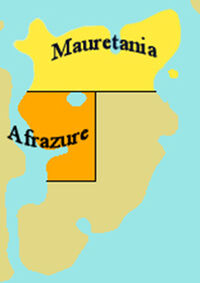
Maurestania and its colony of Afrazure.
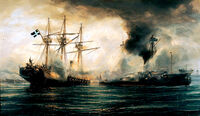
Sinking of an Afrazurean ship at the Battle of the Thrallic Islands.
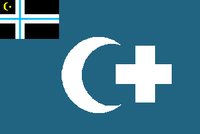
Flag of Maurestani Afrazure.
Maurestania established its colony of Maurestani Afrazure by crowning a colaborationist general, Abdallah bin Mounir, as King of Afrazure, nominally a vassal of the Emperor of Maurestania. However, the true rulers of Afrazure were the Maurestani Office of Colonial Affairs. The colonial office would explore the vast riches of Afrazure, including minerals such as diamonds, gold, platinum and copper, and crops as diverse as coffee, cocoa, bananas, avocados, maize, mangoes and tamarind. Little of the capital gathered with the exporting of these resources, however, was invested in Afrazure itself. Over the colonial period, millions of Afrazureans died from easily-preventable diseases such as typhoid, cholera and malaria, and also from famines - in the great famines of 182-185, more than 700.000 people lost their lives.
Resistance to the Maurestani regime started almost from the beginning of colonial rule. Many soldiers of the Afrazurean Land Forces refused to lay down their arms after the January capitulation. Coordinated resistance began in the spring of 176, under General Bundike Nulabi. His first manifesto demanded the withdrawal of Maurestani forces from Afrazure and declared Meneliq a martyr. Nulabi set a base of operations in what is now northeastern Allacoa and was joined by several regiments of the old Afrazurean army. Over the next decade, Nulabi's troops undertook a guerilla resistance against the Maurestani.
However, this resistance met a furious response. Whole villages which sympathized with Nulabi's cause were burned down by Imperial Maurestani forces and innocent villagers were killed in retaliation for rebel attacks. In one of the biggest massacres, 70.000 women and children from 27 villages were killed in the rebel stronghold region of Great Plateau in 182. Despite the Maurestani atrocities, however, the rebels continued to gain strenght, specially after the famines of 182-185. Soon, Imperial forces lost control of the highlands of Afrazure.
The atrocities contributed to huge migrations within Afrazurean territory. Of the 15 million people living in Maurestani-controlled Afrazure in 176, there were only 10 million by 192. Most of the population had left the major cities and the more fertile areas for other regions of Melania or, mainly, to the rebel-controlled highlands. This was one of the resons for the Trails of Blood: During the 190s, the imperial government of Maurestania campaigned to encourage inhabitants of the "civilized" home provinces, and also new immigrants from Eras and Longerath, to settle in its colony of Afrazure - or, as official propaganda stated, "to bring the light of civilization to the hinterlands". This "civilizing mission" included attacks on the "uncivilized berbers" and members of ethnical minorities.
Entire regions of what is now Afrazure were submited to this process. Members of several Afrazurean tribes were rounded and forced to move by foot to the southern jungle. Clans and tribes of ethnical groups from other parts of the empire, such as the Mahlik and Mixtuptecans of present-day San Patricio, were also forced to march to Afrazure. After this proccess, thousands of Liliance-speaking Maurestani were settled on the now-vacant lands of the coast, while hundreds of thousands of Phenixien- and Fränkisch-speaking immigrants from Longerath and Eras colonized the fertile northern regions of Afrazure.
Thus the current demographic composition of the country came to be: a majority of native ethnic groups, complemented by a minority of Maurestani and descendants from Old World settlers.
Operation Antides and the July Compromises[]

Following the July Compromises, Afrazure was allowed to fly its own flag.
The rebel advances in Afrazure continued. By 225, roughly 40% of the colony was in rebel hands. Maurestania was suffering enormous losses in men and capital. As a result, the Imperial government was becoming increasingly unpopular. On the 16th of March 226, rebel forces launched a major offensive, Operation Antides - which, despite not being particularly succesfull, added to the anti-war and anti-imperial sentiment in Maurestania and opened up the ground for Constituional reforms.
On the 22nd of June 226, absolute monarchy was abolished in Maurestania and negotiations with the Afrazurean rebels were started. With these so-called July Compromise, Maurestania's Office of Colonial Affairs ceased to exist, while the Imperial government handed more powers to the vassal Afrazurean monarchy and ordered the bulk of its forces to be withdrawn. The compromise, however, created a rift in the Afrazurean rebel movement. The "General Nulabi" or Nulabist faction, led by Colonel Haile Kwa wanted the continuation of the guerilla war until independence had been achieved. On the other hand, the "3rd of February" faction led by the legendary freedom fighter Gabo Mhuti, wanted to accept the accord, considering it a road towards independence. This rift was cleverly exploited by the Maurestani, who promised to give command posts in the new Colonial Army to the rebel commanders who agreed to the Compromises. Gabo Mhuti was given the post of commander-in-chief of the new forces.
The rift grew wider with each passing month. Though the Compromises stated nothing regarding the demilitarization of the rebel forces, King Mahmoud IV was becoming increasingly vocal in his demands for the rebels to lay down their weapons. Finally, on November 11th 230, he ordered Gabo Mhuti to initiate hostilities against rebel forces in central Zanga. Mhuti refused and threatened to resign, but fighting nevertheless resumed. This time, having superiority in numbers and equipment, the combined Afrazurean and Maurestani forces were able to crush the rebels in several successive campaigns. In the fall of 235, Haile Kwa was captured and executed, and all armed resistance ceased.
Civil War in Afrazure[]
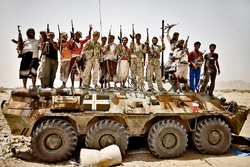
Afrazurean civilians atop a captured Maurestani vehicle, 279.
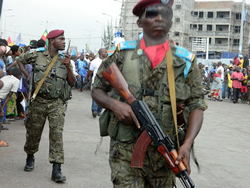
Afrazurean troops on Medhiou, 282.
For three decades, Maurestania followed the July Compromises. Domestic affairs were now almost entirely in the hands of the Afrazurean Government; only foreign affairs were, of course, a reserved matter for Maurestania. Exploitation of natural resources was becoming increasingly neo-colonial - contrasting the purely colonial exploitation of the past. The huge famines could now be avoided, since Maurestania was no longer exporting agricultural produce from the colonies. The Imperial army no longer conducted punitive expeditions against the native population. However, conditions weren't much better for the average colonial subject. The vast majority of the people in Afrazure had no running water or eletricity, people were still dying of tropical diseases, 90% of the population still were illiterate. While a tiny fraction (mainly the bureaucracy and the non-native elites) was extremely rich, the vast majority of the population was extremely poor.
On the 13th of May 268, inspired by a series of pro-democracy riots in Maurestania, students at Kisqa University protested, initially over the issue of poor housing for the students. Soon, the demands icreased, and the protesters started to call for major reforms and full independence from Maurestania. On the 23rd of June, miners and factory workers declared a general strike in Afrazure, followed by peasants on the 11th of July. The Afrazurean government was desperate. Police refused to attack the protesters, while several batallions of the Afrazurean army mutinied. It seemed that the fall of government and the achievment of full independence was imminent.
The king called on Maurestania to intervene. The intervention force quickly regained control of the major cities and towns. Rebellious students were either exiled or killed. Workers' and peasants' protests were put down with the threats of the old colonial horrors repeating.
Through the early 270s, a number of rebel groups started once again to conduct low-scale warfare against Maurestania. These groups were centered around three main factions: the Movement for Free Zanga, the Afrazurean National Liberation Army and the Allacoan National Liberation Front. An agreement among these three organizations led to formation of the Joint Command of the Afrazure Freedom Fighters (JCAFF) in 281.
Neither the people nor the ruling classes of Maurestania were content with the developments in Afrazure. The government sought to quickly disengage from the conflict, while at the same time keeping a loyal government in power once again. The conflict in Afrazure stretched into the 280s, as Maurestania itself entered a major economical recession - caused, among other factors, by the increasing expenses with this colonial war. In 280, Maurestania experimented replacing segments of its forces with foreign mercenary troops - with disastrous results for the Afrazurean population, as many of these mercenary forces commited thousands of well-documented human rights abuses. Under major economical crisis, the last Maurestani batallions left in 288, while Afrazure itself was left divided between the rump pro-Maurestani government of King Mounir, autocratic warlords and the pro-independence rebels.
By 296 most of the highlands of Zanga and Allacoa, and the desert areas of southern Central Afrazah, were under control of the JCAFF. Despite this, the pro-Maurestani Afrazurean government survived - even managing to spare troops to contribute to the disastrous Maurestani invasion of Thistland, on the 16th of April 298.
The Mercantile Empire[]
Afrazure dissolved its last formal ties with Maurestania on the 12th of April 299, when it asked for membership into the United Nations of Vexillium. King Mounir then procceded to rename the nation as the Mercantile Empire of Afrazure - and, with it, the proclamation of a series of economical reforms with the goal of bringing major revenue into the Afrazurean treasury, emptied by the years of neglection, corruption, nepotism and foreign rule. With no pay, however, the Imperial Guard, composed entirely of mercenaries, also mutinied. The emperor was merely in control of Medhiou, while the mercenary warlords, nominally loyal to him, raged across the rest of country.
Partition of Afrazure[]
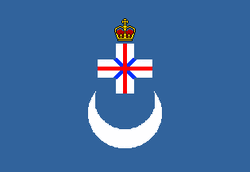
Flag of Afrazure Altlandique.
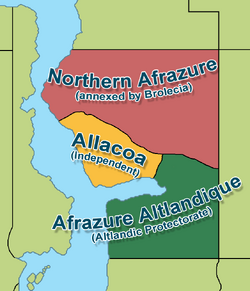
Partition of the former Empire of Afrazure, situation by the end of 300AP.
Following the demise of Maurestania due to the outcome of the Maurestani War, the new republic of Brolecia, one of the Maurestani successor states, annexed northern Afrazure in the 5th of July 299. These new territories were incorporated into the republic as the states of Skruyu, Estuary, Flenyitty and the Autonomous Region of Zanga.
After this first action, the Kingdom of Altland, which had a stake in the welfare of Afrazure through the presence of numerous Church of Altland missionaries, decided on the formal deposition of the by-then practically powerless king and a partition of the remaining territory. After secret negotiations, carried on for Altland by Sir Alexander Alexicot and Sir Rijnheld Kenigsthral, the corelands of Afrazure, including the traditional capital of Medhinou, was made into a protectorate of the Altlandic Crown, under supervision of the United Nations of Vexillum Committee on Collapsed Nations (UNVCOCN).
The remainder of Afrazure was granted by the UNVCOCN to the Yellow Free State - a former country in Ishrakan. The JCAFF rebellion would continue, now directed solely against the Yellow Free State regime, until October 299, when the YFS troops surrendered and the independence of Allacoa was declared.
The transfer of the Afrazurean corelands to Altland was internationally recognized in November 299, following the visit of the Altlandic monarch, George II. Afrazure was formally organized as a protectorate of Altland in 300, under the name Afrazure Altlandique. The first Altlandic governor-general was Sir Genthar Jengling, being succeeded by Sir Herald Oksenstal.
In 305, complete sovereignty was restored to the country, under the name Kingdom of Afrazure, though it remains a member of the Altlandic Family of Nations.
Geography[]
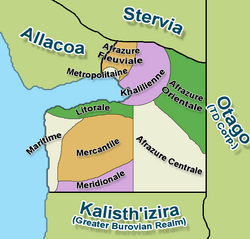
Provinces of Afrazure.
Afrazure is located in western Melania, bordering Allacoa, Stervia, the Burovian dominion of Kalisth'izira and the Trade and Development Corporation Territory at Otago. The country is divided in nine provinces: Afrazure Centrale, Afrazure Fleuviale, Afrazure Orientale, Khalilienne, Litorale, Maritime, Mercantile, Meridionale and Metropolitaine.
Demographics[]
Afrazure has diverse ethnic backgrounds. Broadly speaking, roughly 70% of the population of 17.950.000 (est. 320) descend from indigenous Afrayenne (black) peoples, 20% descend from (white) settlers of Longerath and Eras, and 10% are Maursetani. According to local legends, the indigenous groups all trace their origins from seven lost tribes - nowadays, apart from the main ethnic divisions, the local populations claim descent from a number of families, clans or tribes. There are also minorities of Mixtuptecans, Extremans, Stervians and other ethnic groups of former Maurestania.
The Afrazurean population follows three main religions. Cruisans form the majority amongst the white population in the coastal areas - most are followers of the Church of Altland, although there is a presence of several other Cruisan denominations in the country. Animists are concentrated on the southwestern tribes and hinterlands. Mounists, spread across the country, form the majority of the population. Most Mounists in Afrazure follow a form of Maurestani Mounism with local adaptations.
Being a former part of the Maurestani Empire, Afrazure follows the customary Four Rules of God, which forbid public denigration of other religions, aggressive proselytizing, gross immorality and sedition.
Afrazlala is the official language of Afrazure, spoken by over 70% of the population - although dozens of other indigenous languages are also spoken throughout the territory. There are also small percentages of speakers of Maurestani and Phenixien.
Government[]
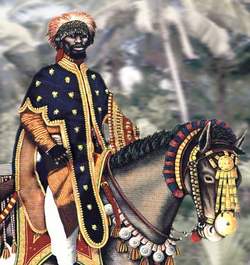
Official portrait of His Highness, Youssef II.
Afrazure is a kingdom, under His Highness, Youssef II. The king also holds the traditional title of Obango, paramount chief of the Afrazurean tribes. The monarch rules in conjunction with a bicameral parliament, a Grand Council of Mayors and Chieftains, and a Prime-Minister. Historically, the Prime-Minister has always been a Mounist - this is no longer a legal provision, however. The Altlandic Family of Nations is represented by a governor-general, which acts as a counselor to the king.
The judicial system follows modern standards although, in the hinterlands, tribal local courts are common for minor offenses.
During the 300-305 protectorate period, foreign relations were conducted on Afrazure's behalf by the Kingdom of Altland, although a number of countries did mantain consular representations in Medhiou.
Economy[]
During the colonial period, the wealth of Afrazure was concentrated in the hands of a small urban elite. The period was marked by widespread poverty, occasional famine, and even the practice of slavery in the most remote areas. Agriculture has historically been limited to areas along the coasts and on the banks of the Great Elephant River, mainly for cash crops destined for exporting. Following the establishment of the Altlandic protectorate, the economy has been steadily rebuilt. These policies have continued as the independence was restored following 305AP.
The former currrency of Afrazure was the Défense, which was divided into 100 Bananes. Nowadays, Altlandic currency is legal tender in Afrazure. A local version of the Altlandic Pende, called the Panga, is issued by the Bank of Altland and pegged to the Altlandic coin.
National symbols[]
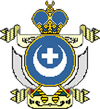
Coat of arms of Afrazure
See also: Symbols of Afrazure
The national flag of Afrazure contains symbols of the two main religions of the country, the crescent for Mounism and the cross for Cruisanism, upon a field of the distinctive "Afrazurean" blue.
The coat of arms of Afrazure displays both the cross and crescent upon a field of the traditional blue, supported by two native scimitars and surmounted by a representation of the royal crown. Beneath, a scoll bearing the national motto, Tembo Erabe Iffriquiyah ("The Big Elephant is the Shield of Afrazure"), in ancient Afrazlalic script.
The previous national anthem, which bears this motto as its title and first words, was retained under the Altlandic Protectorate.
Ancient symbols of Afrazure include a seven-pointed star, symbolizing the legendary "seven tribes" from which all the peoples of the region descend; and the elephant, considered the royal animal of Afrazure.
| |||
|---|---|---|---|
Altland (Fort Capital) • Afrazure • Disonda • Port Marie • Phenixia |
| |||
| San Patricio |